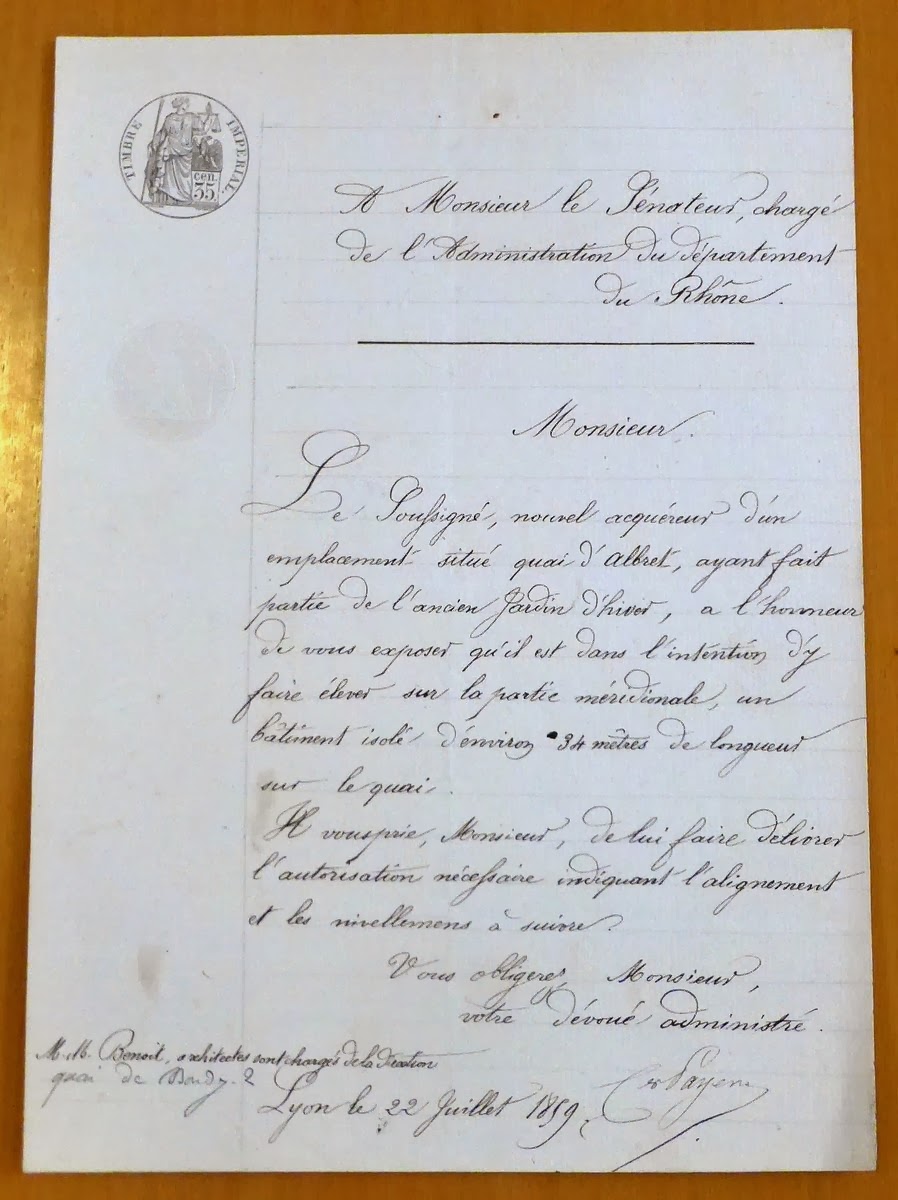The grand Louis XIII-style building situated at 8 Rue Godefroy in the upmarket 6th arrondissement is completely unique in Lyon and considered one of the city's most important hôtels particulier (mansions). Yet it isn't a stop on any of the innumerable guided tours. Nor is it featured in any of the guidebooks that I've come across. It is therefore theoretically ideal for inclusion on the Invisible Lyon blog.
However, when one of my readers asked me to look into its past, I soon found that this was a lot easier said than done.
 |
| The architect: Claude-Anthelme Benoit |
With a little googling, it wasn't too difficult to discover that the five-storey building was designed and constructed, apparently in 1857, by Lyon-born architect Claude-Anthelme Benoit (1794-1876) on a triangle of land sandwiched between Rue Godefroy, Quai de Serbie and Rue du Docteur Mouisset.
At the time of the building's construction, the Quai de Serbie along the River Rhône was still known as the Quai d'Albret, after Jeanne d'Albret, the driving force behind the French Huguenot movement and the mother of the future "Good King Henry" (Henri IV), a woman much loved by the people of Lyon.
Similarly, the Rue du Docteur Mouisset, named after a tuberculosis researcher Frédéric Mouisset (1860-1938), was still the Rue Montgolfier in the 19th century.
At the time of the building's construction, the Quai de Serbie along the River Rhône was still known as the Quai d'Albret, after Jeanne d'Albret, the driving force behind the French Huguenot movement and the mother of the future "Good King Henry" (Henri IV), a woman much loved by the people of Lyon.
Similarly, the Rue du Docteur Mouisset, named after a tuberculosis researcher Frédéric Mouisset (1860-1938), was still the Rue Montgolfier in the 19th century.
Rue Godefroy, which the front of the building faces, got its name from Godefroy de Bouillon, the man who led the first crusade and was crowned king of Jerusalem. Although several crusades passed through Lyon, Bouillon's started further east. The appellation is therefore merely honorific rather than indicative of any specific link.
The U-shaped building at number 8 stands near the northernmost tip of Rue Godefroy. Four floors high, it encircles a small courtyard. In a unique flourish, both the courtyard and the adjacent paved garden, dominated by a large tree, are bounded by wrought iron railings.
 In 1940, the chemist and editor Marc Barbezat (1913-1999) began producing a literary review entitled L'Arbalète at 8 Rue Godefroy. The following year he opened a publishing house at the same address, which became famous in particular for being the first to publish the works of Jean Genet. A total of 13 editions of L'Arbalète were published until 1948, including extracts of works by, amongst others, Antonin Artaud, Mouloudji, Michel Leiris, Paul Claudel, Raymond Queneau, Jean-Paul Sartre, Ernest Hemingway, Henri Michaux and Louis-René des Forêts. The Arbalète publishing house was eventually bought by Gallimard in 1997.
In 1940, the chemist and editor Marc Barbezat (1913-1999) began producing a literary review entitled L'Arbalète at 8 Rue Godefroy. The following year he opened a publishing house at the same address, which became famous in particular for being the first to publish the works of Jean Genet. A total of 13 editions of L'Arbalète were published until 1948, including extracts of works by, amongst others, Antonin Artaud, Mouloudji, Michel Leiris, Paul Claudel, Raymond Queneau, Jean-Paul Sartre, Ernest Hemingway, Henri Michaux and Louis-René des Forêts. The Arbalète publishing house was eventually bought by Gallimard in 1997. From about 1950 onwards, the Swiss Consulate-General had its offices at 8 Rue Godefroy, before moving to Venissieux in 1993. The building is currently occupied by, amongst others, a series of what appear to be letterbox real-estate firms, most of which seemingly owned by the same person, and an extremely exclusive managers' club: Le Prisme.
 |
| Doctor who? |
Swiss consular staff regretted to inform me that they didn't have an archive and therefore all the papers dating back to their 40-plus years at the Hôtel Payen had been destroyed. Le Prisme apparently turned up its nose at my enquiry. A doctor working in the building, whose name appears merely as initials on the doorbell, didn't answer until after I had posted the findings of my research.
And then, just as I thought I had reached a complete dead-end, I got the breakthrough I needed in the form of an reply from the Archives de Lyon: they had found several documents from the late 1850s relating to the house in question. Hurrying over there, I discovered that the paper was filed not under Rue Godefroy, the actual address, but under Quai d'Albret.
The document, shown below, was a building permit dated 1 August 1859 - not 1857, as cited repeatedly elsewhere - and made out to a Monsieur Payen.
 |
| The original construction permit, found in the municipal archives |
Attached to the building permit was the original application. It was signed "Ch. Payen", which an archivist told me was the common abbreviation for Charles. The last piece of the puzzle fell into place when I consulted the 1865 municipal indicateur (directory). This listed the house's principal resident and owner as "PAYEN (Ch.), ind. de soie".
 |
| The application, signed "Ch. Payen" and dated 1859 |
 |
| The man himself: Charles Payen |
In 1859, Charles' wife, Jeanne-Emilie Roussel (1831-1921), acquired the land that had previously housed the Jardin d'Hiver, a winter garden which pre-dated the Parc de la Tête d'Or slightly further east, designed by the famous Parisian architect Hector Horeau (1801-1872) and opened in December 1847.
On this land Payen had the architect Benoit build the house subsequently referred to as the Hôtel Payen, where Charles and Emilie lived with their eight children: Gaston Louis Jean (1851-1902), Louis (1852-1924), Claire (1853-1864), Marie (1856-1878), Gabrielle (1857-1924), Gaëtan (1860-1927), Robert (1863-1924) and Alice (1869-?).
Charles Payen died at his family home - 8 Rue Godefroy - at 10 o'clock on the morning of 20 February 1910. He was 94.
 |
| Charles Payen's death notice |
 |
| The front of the Hôtel Payen |
And there the circle closes.
____________
Post scriptum: A few weeks after I had posted this article, I was contacted by one of the great-grandsons of Charles Payen, who had been alerted to my researches by two of the people I had written to. In addition to showing me photographs and family trees of his ancestor, filling me in on some of the family history and giving me a tour of 8 Rue Godefroy, he took me to the nearby Eglise de la Rédemption, which lies a few streets away and can be seen directly from corner of Rue Godefroy and Rue du Docteur Mouisset.
 |
| Charles Payen (top left) in the Eglise de la Rédemption |
Charles Payen was undoubtedly one of the main benefactors of the church because in the back of the Eglise de la Rédemption there is a stained-glass window depicting three men behind a table on which a piece of paper marked "souscription" (contribution) is weighed down by a money-bag. One of these men is bearded: Charles Payen.
 |
| One of these floors is not like the others |
As it turns out, the plans for the top of the house were very different. However, in 1860, while construction was still under way, Payen had sent an urgent message from Japan, urging that the roof be put on his house immediately because the silk market had crashed and he was worried whether he would be able to continue paying for the construction of such a lavish edifice.
Unfortunately, Benoit's original plans have disappeared and may have been lost or destroyed. Nevertheless, Charles Payen's descendants are still searching for them in the hope that they can one day complete their illustrious forefather's home as he had envisaged it.
This post was the result of a request from a reader. If you would like to suggest a hidden gem for inclusion on the Invisible Lyon blog or have something Lyon-related that you would like me to investigate further, feel free to drop me a line at invisiblelyon@gmail.com]
Locate 8 Rue Godefroy on Google Maps













I'm sorry it took me such a long time to respond. I seldom access my blog these days, so I was unaware that you had left a comment. I follow you on Facebook but somehow didn't see this post in my feed.
ReplyDeleteBut this! How incredible, how entirely fascinating! "Charles Payen died at his family home - 8 Rue Godefroy - at 9 o'clock on the morning of 20 February 1910. He was 94"! What a remarkable story! Thank you, thank you, thank you so much, for doing this research and writing this post. It must have been such work. I hope you felt rewarded, though, with what you discovered.
I can now remember this building with more warm thoughts, feeling as if I've gotten to know it better. This is lovely.
On a side note, the story about Église de la Rédemption made me smile. When we first moved to Lyon and were looking for an apartment, we looked at two places. One was at place de Chavannes. We ended up taking the other one, looking down on place Lyautey, but place de Chavannes and Église de la Rédemption were often on my route to the market, shops, Parc de la Tête d'Or, etc., etc., and that square with the playground was one of our favorite places to spend time.
This blog post has piqued my interest and I'd love to learn more about this hidden gem.
ReplyDelete